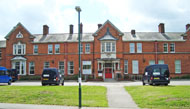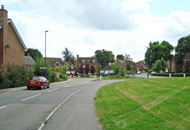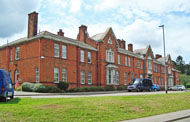Long-stay paediatric
In 1896 the Metropolitan Asylums Board (MAB) acquired a 136 acre site at Carshalton Beeches. It was intended for an 800-bedded hospital for convalescents. Completed in 1908, it was named the Southern Hospital.
However, in September 1908, MAB was tasked with providing care for sick and debilitated London children. It was believed that the countryside with its fresh air and sunshine was the ideal place for such poor and malnourished children to recover. The Board decided to use the Southern Hospital at Carshalton for this purpose and handed over the new hospital to the Children's Committee, who renamed it the Children's Infirmary. (The Gore Farm Hospital at Darenth later became a general convalescent hospital and was renamed the Southern Hospital.)
The Children's Infirmary opened in 1909, with 1000 beds and a staff of 300. The young patients were accommodated in single storey ward blocks or 'cottages', which were arranged in 24 pairs. Two blocks for surgical cases were at the south of the site. MAB also established its first Nursing Training School at the Infirmary. The administrative block was at the north of the site, near the entrance, together with the porter's lodge, staff accommodation, kitchens and laundry.
In 1914 Queen Mary agreed to be patron and in 1915, after she had visited, it was renamed Queen Mary's Hospital for Children.
By 1921 the Hospital had 810 beds. In 1926 it began to admit children with rheumatic fever, a common disease at the time which caused joint pains and structural heart disease.
The Hospital was extended during 1928-1930 at the cost of £207,600. Two new ward blocks and four staff blocks were added, as well as a block with a kitchen and dining room. By then 350 children were being treated for rheumatic diseases, as well as 500 children with non-pulmonary tuberculosis (TB), that is, of the bones and joints (mainly affecting the spine, hip and knee), and abdominal and other organs.
During WW2 the Hospital was one of the most heavily bombed in London, perhaps due to its location. It was decided to evacuate the children in 1944 because of the new threats posed by the V1 flying bombs and V2 rockets.After the war the Hospital re-opened, but war damage to the buildings had reduced the numbers of beds from 1284 to 840. It joined the NHS in 1948. The introduction of Streptomycin and other antibiotics enabled better and faster treatment of TB; the Hospital began to provide care for children with polio and cerebral palsy.
By 1959 it was caring for children with special needs. When the mentally handicapped children were transferred from the run-down Fountain Hospital, it became the first fully comprehensive children's hospital, treating both physically and mentally sick children on one site.
By the late 1970s it was the largest children's hospital in Europe. As most of its patients were in long-stay care, it had its own school. It even had a zoo and a miniature railway. A medical engineering unit opened on the site. It provided specific aids and instruments for physically handicapped children to enable them to become more mobile and to enjoy indoor and outdoor activities.
With improvement in medical treatments and subsequent reduction in admissions, and a change in political ethos about patients kept in long-stay hospitals, the Hospital became redundant. By 1989 it had only 132 beds for acute patients and 201 for those with mentally handicap.
The Hospital closed in 1993. The services were transferred to St Helier Hospital, but it has kept its name on that site.
Orchard Hill Hospital, which provides accommodation for long-stay mentally handicapped adults, remains on the Carshalton site, but is also destined to close.
Present status (August 2008)
The Hospital buildings on the eastern part of the site were demolished and the area was redeveloped for residential use during the 1990s. However, the administration block, the medical superintendent's house and a number of other buildings survive.
Stanley Park High School is due to open on the site in 2010.

The entrance roundabout on Fountain Drive.

The former medical superintendent's house.

The administration building, former Headquarters of the Trust, is due to be demolished.


The boarded-up porter's lodge.

The administration building as seen from the east.

The front entrance of the administration building.
Earl E 1996 Queen Mary's Hospital for Children: an Historical Account Through Words and Pictures. Vol. I. Knebworth, Able.
Earl E 2001 A Vision of Healing. Queen Mary's Hospital for Children. Vol. II. Knebworth, Able.
http://archiseek.com (1)
http://archiseek.com (2)
http://hansard.millbanksystems.com
https://britainfromabove.org.uk
www.bbc.co.uk
www.busybeeschildcare.co.uk
www.britishpathe.com
www.epsom-sthelier.nhs.uk
www.flickr.com
www.geograph.org.uk (1)
www.geograph.org.uk (2)
www.londonsscreenarchives.org.uk
www.meru.org.uk
www.queenmarys.org.uk
www.uk-hub.com
www.workhouses.org.uk
Return to home page